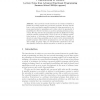Free Online Productivity Tools
i2Speak
i2Symbol
i2OCR
iTex2Img
iWeb2Print
iWeb2Shot
i2Type
iPdf2Split
iPdf2Merge
i2Bopomofo
i2Arabic
i2Style
i2Image
i2PDF
iLatex2Rtf
Sci2ools
AFP
2008
Springer
2008
Springer
A Tutorial on Parallel and Concurrent Programming in Haskell
This practical tutorial introduces the features available in Haskell for writing parallel and concurrent programs. We first describe how to write semi-explicit parallel programs by using annotations to express opportunities for parallelism and to help control the granularity of parallelism for effective execution on modern operating systems and processors. We then describe the mechanisms provided by Haskell for writing explicitly parallel programs with a focus on the use of software transactional memory to help share information between threads. Finally, we show how nested data parallelism can be used to write deterministically parallel programs which allows programmers to use rich data types in data parallel programs which are automatically transformed into flat data parallel versions for efficient execution on multi-core processors.
| Added | 01 Jun 2010 |
| Updated | 01 Jun 2010 |
| Type | Conference |
| Year | 2008 |
| Where | AFP |
| Authors | Simon L. Peyton Jones, Satnam Singh |
Comments (0)

